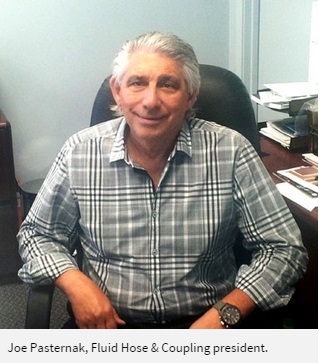Canadian company unveils corrosion-resistant hose
Canadian company unveils corrosion-resistant hose
 MISSISSAUGA, Ontario—Fluid Hose & Coupling Inc. is marketing a hose it helped develop to improve the transfer of highly corrosive materials used in steel and mining industry applications.
MISSISSAUGA, Ontario—Fluid Hose & Coupling Inc. is marketing a hose it helped develop to improve the transfer of highly corrosive materials used in steel and mining industry applications.
The Coreblast-brand hose is abrasion and corrosion resistant, allowing for the hose to have longer life and keeping end users from constantly having to replace the hose as they do with current products, according to Joe Pasternak, Fluid Hose & Coupling president.
“We've geared ourselves to specialty markets,” he said. “We do a lot in the steel and petroleum industries and different types of OEM markets. We like to find a niche in each industry.”
Mississauga-based Fluid Hose & Coupling—founded in 1979—focuses its business on three main areas: selling hydraulic hose to original equipment manufacturers and distributors, with the Manuli and Goodyear brands its biggest lines; distributing all types of industrial hose, again with the Goodyear brand its most prominent line; and manufacturing fittings for gas pump hoses.
The Coreblast hose is used for transporting materials such as iron residue and mending materials into blast furnaces; as an industrial waste and raw material transfer hose; and for suction delivery of a variety of extremely abrasive products.
With one of its main markets being steel, Fluid Hose & Coupling wanted to work on finding a hose that could carry abrasive carbon that was injected into furnaces to make the steel formable into many shapes. Pasternak said steel mills generally used either an expensive ceramic product or a cheap material handling hose that had to be replaced every few days, which led to increased downtime expenses.
Pasternak's firm spent four years trying to find a solution to the problem, partnering with a hose manufacturer in Italy that he declined to name. The companies came up with the Coreblast hose, for which Fluid Hose & Coupling has exclusive rights in North America, he said.
One problem was finding a material flexible enough to transport the carbon but tough enough so the carbon wouldn't quickly break down the rubber or other materials.
For Coreblast, Fluid Hose and its partner settled on a polyurethane tube with synthetic plies, a steel wire helix and copper wires to discharge static electricity. The cover is a corrugated black CR rubber, and the hose can work in a temperature range of -30°C to 100°C.
Passing every test

Pasternak said the tube and cover together give Coreblast the needed flexibility, and the hose is designed so that material won't hit any parts within the tube to provide improved flow.
“When we first came out with it, we went to three companies to ask them to try it,” he said. “It was the most severe applications. It passed every test, then we made the tube even better to make sure you get the life out of the hose that we are promising.”
One of the customers was ArcelorMittal Point Lisas Ltd. in Trinidad and Tobago, part of the global steel and mining company.
Steve King, manager of materials at the Caribbean location, said his maintenance crew was removing 20-foot lengths of hose every three to four days. “This was a very time-consuming process that delayed production needlessly,” he said.
After switching to Coreblast, King said the premium hose now lasts two to three months before it needs to be replaced. “It has greatly reduced downtime, is flexible and easy to handle,” he said.
Pasternak said that since the hose has been on the market, “every customer we've sold it to has now reordered it.”
He said the toughest part of selling the hose is to convince an end user to try it initially.
Pasternak said Coreblast is less expensive than the ceramic products but still lasts longer. It is more expensive than the material handling hoses, but because it lasts several months compared to a few days, in the end it yields a much cheaper hose per hour usage cost.
“Our biggest challenge is to find distributors who have connections with these maintenance people,” Pasternak said.
Fluid Hose & Coupling has Ontario locations in Mississauga and Hamilton and added a site in Shanghai within the last two years to service some of its OEMs that have opened in China. Its fittings are made at an undisclosed location in the northern U.S. and also at a site in China.
The firm employs about 60. Pasternak declined to release sales.
Source: http://www.fluidhose.com/assets/rubbernews.com---where-t...try-gets-its-news-first.pdf